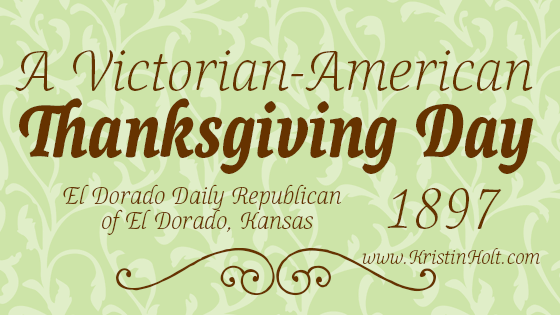
Victorian-American New Year’s Etiquette
Victorian-American newspapers illustrate the rules of etiquette governing New Year’s calls. Society’s expectations were made public and adherence expected. What did proper decorum require on January 1?

Victorian-American newspapers illustrate the rules of etiquette governing New Year’s calls. Society’s expectations were made public and adherence expected. What did proper decorum require on January 1?

A newspaper article published on November 25, 1897 (El Dorado, KS, syndicated from NY Tribune) sheds historical light on what Thanksgiving Day was to the late Victorians in the United States. Includes: origins, thanksgiving souvenirs, thanksgiving entertainments, and thanksgiving decorations… a glimpse into Thanksgiving in 1897.

Nineteenth Century popular belief–wholly supported by Medical Doctors’ and scientists’ claims–genuinely believed that educating females in the same manner as males invited an entire host of disastrous results. Those terrifying results included everything from destruction to the woman’s reproductive system, mental breaks (yes, insanity!), and a long list of physical diseases. Because the vast majority believed these consequences to be true, women weren’t allowed to seek education in a male-dominated classroom. The battle over co-education continued long after the late 19th Century for these reasons. Not only was the woman’s mind and body at terrible risk, should she be educated like a male, but everyone knew a female mind couldn’t take in significant learning.

Nineteenth Century American women who desired an advanced education (and to work as a professional) fought an uphill battle. As late as the final decade (1890s) cultural beliefs demanded “good” women made home a bit of heaven on earth, toiled only as a help-meet to her husband, and found all the joy and satisfaction there she could possibly need. Historical sources underscore this dated belief system, and set the stage for the challenges faced by my character Dr. Isabella Pattison, DDS, in Isabella’s Calico Groom (within Calico Ball: Timeless Western Collection).

This article contains the transcription of a brief recounting of one five-year-old boy’s letter to Santa Claus, published in Chicago Daily Tribune on December 26, 1883. The vintage newspaper report sheds light upon the attitudes and perceptions of our late Victorian-era ancestors, a young and well-to-do boy’s Christmas wish-list, and how his parents must have attempted to impress upon him an awareness of the good he might do for others. I find it interesting that residents of the Old Ladies’ Home are referred to as “inmates”.